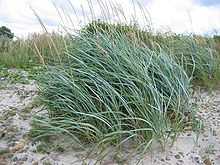Leymus arenarius
| Leymus arenarius | |
|---|---|
 | |
| Scientific classification | |
| Kingdom: | Plantae |
| (unranked): | Angiosperms |
| (unranked): | Monocots |
| (unranked): | Commelinids |
| Order: | Poales |
| Family: | Poaceae |
| Genus: | Leymus |
| Species: | L. arenarius |
| Binomial name | |
| Leymus arenarius (L.) Hochst. | |
Leymus arenarius (L.) Hochst. (syn. Elymus arenarius L.) is a psammophylic (sand-loving) species of grass in the Poaceae family, native to Atlantic, Central and Northern Europe and the coldest shores of North America.
Leymus arenarius is commonly known as sea lyme grass, or simply lyme grass.[1]
In the Canadian Arctic, Leymus arenarius is used by Inuit people for basket weaving. Sanikiluaq, Nunavut is particularly known for its sea lyme basketry – a tradition that died out for two decades but has since been revived.[1]
In Europe, the plant's stems are used for roof thatching and can be woven into a coarse fabric. Seeds have provided food in the past. Beginning as early as the 18th century, the plant's extensive network of roots was used in stabilizing sands on northern coastal beaches.[2]
During the 17th century reign of William III, the Scottish Parliament passed a law protecting Leymus arenarius. Under the 18th century reign of George I, the British Parliament expanded the law to protect the plant on English coasts. This law went as far as declaring the cutting or possession of the grass to be a penal offense.[2]
References
- ↑ 1.0 1.1 Sankiliuaq. Canada's Arctic: Nunavut. (retrieved 16 March 2009)
- ↑ 2.0 2.1 Sea Lyme Grass. Plant Guide. (retrieved 11 April 2009)